
myCBSEguide App
Download the app to get CBSE Sample Papers 2023-24, NCERT Solutions (Revised), Most Important Questions, Previous Year Question Bank, Mock Tests, and Detailed Notes.
Install NowCBSE class 10 Science Chapter 1 Chemical Reactions and Equations notes in PDF are available for free download in myCBSEguide mobile app. The best app for CBSE students now provides Chemical Reactions and Equations class 10 Notes Science latest chapter wise notes for quick preparation of CBSE board exams and school based annual examinations. Class 10 Science notes on chapter 1 Chemical Reactions and Equations are also available for download in CBSE Guide website.
CBSE Guide Chemical Reactions and Equations class 10 Notes
CBSE guide notes are the comprehensive notes which covers the latest syllabus of CBSE and NCERT. It includes all the topics given in NCERT class 10 Science text book. Users can download CBSE guide quick revision notes from myCBSEguide mobile app and my CBSE guide website.
10 Science notes Chapter 1 Chemical Reactions and Equations
Download CBSE class 10th revision notes for chapter 1 Chemical Reactions and Equations in PDF format for free. Download revision notes for Chemical Reactions and Equations class 10 Notes and score high in exams. These are the Chemical Reactions and Equations class 10 Notes prepared by team of expert teachers. The revision notes help you revise the whole chapter in minutes. Revising notes in exam days is on of the best tips recommended by teachers during exam days.
Revision notes for Class 10 Science Download as PDF

CBSE Class 10 Science Revision Notes Chapter 1 Chemical Reactions and Equations
Chemical Reaction : Whenever a chemical change occurs we can say that a chemical reaction (permanent change) has taken place which can be expressed symbolically by a chemical equation.
e.g. Food gets digested in our body
- Rusting of iron.
magnesium is burnt in air to form magnesium oxide. This chemical reaction can be represented as
- We can observe or recognise a chemical reaction by observing change in state, colour, by evolution of gas or by change in temperature.
- Physical state of the reactants and the products are mentioned to make chemical reaction more informative. e.g. we use (g) for gas, (l) for liquid, (s) for solid and (aq) for aqueous.
Balanced Equation : A balanced equation is one in which the number of atoms on the reactant and product sides are equal.
Balancing Equation : We balance a chemical equation so that no. of atoms of each element involved in the reaction remains the same at the reactant and product side.

Types of Reaction
I. Combination Reaction :– The reaction in which two or more substances combine to form a new single substance.
e.g.
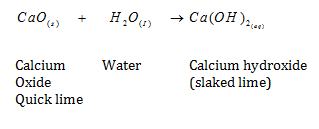
- slaked lime is used for white washing walls. It reacts with to form Calcium Carbonate and gives a shiny finish to the walls
Calcium Hydroxide Calcium Carbonate
(ii) Burning of Coal
heat+ light
(iii) Formation of water
Exothermic Reactions : Reaction in which heat is released along with the formation of products.
eg..
Endothermic Reaction :The reactions which require energy in form of heat, light or electricity are called endothermic reaction
eg..
II. Decomposition Reactions :The reaction in which a single substance decomposes to give two or more substances. De composition reactions can be of three types:
DECOMPOSITION REACTIONS :-
- Thermal Decompostition :-When a decomposition reaction is carried out by heating
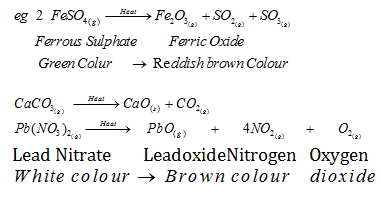
- Electrolytic Decomposition :- When a decomposition reaction is carried out by electric current,
- .
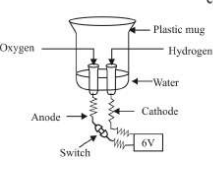
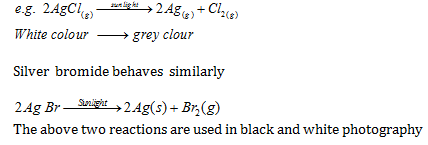
- Silver bromide behaves similarly
III. Displacement Reaction:The chemical reaction in which an element displaces another element from its solution
Copper (aq)
Sulphate Iron Sulphate
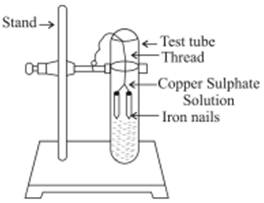
Fe being more reactive than Cu displaces it from
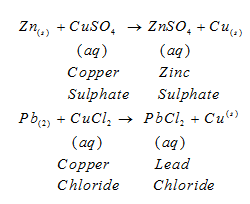
- Zinc and lead are more reactive elements than copper. They displace copper from its compounds.
IV. Double Displacement Reaction :The reaction in which two different atoms or group of atoms are mutually exchanged
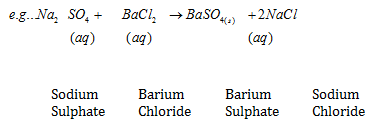
A white substance is formed due to above reaction. The insoluble substance i.e., is called precipitate.
Precipitation Reaction – Any reaction that produces a precipitate is called a precipitation reaction.

the downward facing arrown represents the formation of precipitate.
V. Oxidation :Oxidation is the gain of oxygen or loss of hydrogen
When copper is heated a black colour appears. If this CuO is reactedwith hydrogen gas then again Cu becomes brown as reverse reaction takes place
VI. Reduction : Reduction is the loss of oxygen or gain of hydrogen.
- Redox Reaction : The reaction in which one reactant gets oxidised while other gets reduced
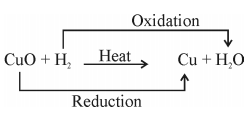
eg..
- Corrosion :When a metal is attacked by substances around it such as moisture, acids etc.
(i) Rusting of iron. i.e Reddish brown coating on iron of is formed.
(ii) Black coating on Silver.
Rusting of iron can be prevented by painting, oiling the surface or by galvanisation.
- Rancidity :When fats and oils are oxidised they become rancidand their smell and taste change.
- Antioxidants are added to foods containing fats and oil.
e.g.is added to packet of chips to prevent oxidation of fats and oils.
Chemical Reactions and Equations class 10 Notes Science
- CBSE Revision notes (PDF Download) Free
- CBSE Revision notes for Class 10 Science PDF
- Revision notes Class 10 Science – CBSE
- CBSE Revisions notes and Key Points Class 10 Science
- Summary of the NCERT books all chapters in Science class 10
- Short notes for CBSE class 10th Science
- Key notes and chapter summary of Science class 10
- Quick revision notes for CBSE board exams
CBSE Class 10 Revision Notes and Key Points
Chemical Reactions and Equations class 10 Notes. CBSE quick revision note for Class-10 Science, Chemistry, Maths, Biology and other subject are very helpful to revise the whole syllabus during exam days. The revision notes covers all important formulas and concepts given in the chapter. Even if you wish to have an overview of a chapter, quick revision notes are here to do if for you. These notes will certainly save your time during stressful exam days.
To download Chemical Reactions and Equations class 10 Notes, sample paper for class 10 Mathematics, Social Science, Science, English Communicative; do check myCBSEguide app or website. myCBSEguide provides sample papers with solution, test papers for chapter-wise practice, NCERT solutions, NCERT Exemplar solutions, quick revision notes for ready reference, CBSE guess papers and CBSE important question papers. Sample Paper all are made available through the best app for CBSE students and myCBSEguide website.
- Acids Bases and Salts class 10 Notes Science
- Metals and Non-metals class 10 Notes Science
- Carbon and its Compounds class 10 Notes Science
- Periodic Classification of Elements class 10 Notes Science
- Life Processes class 10 Notes Science
- Control and Coordination class 10 Notes Science
- How do Organisms Reproduce class 10 Notes Science
- Heredity and Evolution class 10 Notes Science
- Light Reflection and Refraction class 10 Notes Science
- Human Eye and Colourful World class 10 Notes Science
- Electricity class 10 Notes Science
- Magnetic Effects of Electric Current class 10 Notes Science
- Sources of Energy Current class 10 Notes Science
- Our Environment class 10 Notes Science
- Management of Natural Resources class 10 Notes Science

Test Generator
Create question paper PDF and online tests with your own name & logo in minutes.
Create Now
myCBSEguide
Question Bank, Mock Tests, Exam Papers, NCERT Solutions, Sample Papers, Notes
Install Now
Nice notes
Nice notes
I thank to you because this nots very help me ???
??
Excellent notes